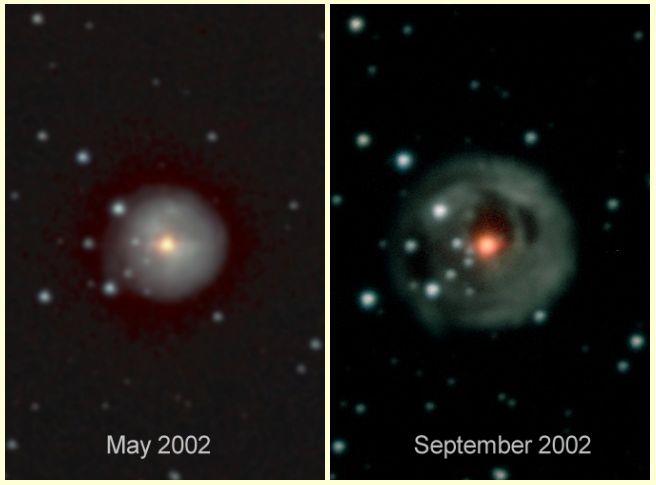Credit & Copyright: Lisa Crause
(Univ. Cape Town),
Warrick Lawson
(Australian Defence Force Academy)
Explanation:
A leading candidate for the most mysterious star found in recent
times is variable star
V838 Monocerotis.
At a distance of about 8,000 light-years, V838
Mon was
discovered
to be in outburst in January of this year.
Initially thought to be a familiar type of
classical nova, astronomers
quickly realized that instead, V838 Mon may be a totally new addition to
the astronomical zoo.
Observations indicate
that the erupting star transformed itself
over a period of months from a small under-luminous star a little
hotter than the Sun, to a highly-luminous, cool supergiant star undergoing
rapid and complex brightness changes.
The transformation defies the conventional understanding of
stellar life cycles.
A most notable feature of V838 Mon is the "expanding" nebula which
now appears to surround it.
Seen above in two separate images from the
South African Astronomical
Observatory's 1 meter telescope,
the nebula is probably a light echo
from
shells of formerly unseen material lost by the star
during its previous evolution.
Light-years in diameter, the shells progressively reflect
the light from
V838 Mon's
outbursts, providing
an opportunity to look back at the history of this
remarkable star's behaviour.
1999 2000 2001 2002 2003 2004 2005 2006 2007 2008 2009 2010 2011 2012 2013 2014 2015 2016 2017 2018 2019 2020 2021 2022 2023 2024 2025 |
Yanvar' Fevral' Mart Aprel' Mai Iyun' Iyul' Avgust Sentyabr' Oktyabr' Noyabr' Dekabr' |
NASA Web Site Statements, Warnings, and Disclaimers
NASA Official: Jay Norris. Specific rights apply.
A service of: LHEA at NASA / GSFC
& Michigan Tech. U.
|
Publikacii s klyuchevymi slovami:
variable star - Peremennye zvezdy - v838 mon
Publikacii so slovami: variable star - Peremennye zvezdy - v838 mon | |
Sm. takzhe:
Vse publikacii na tu zhe temu >> | |
